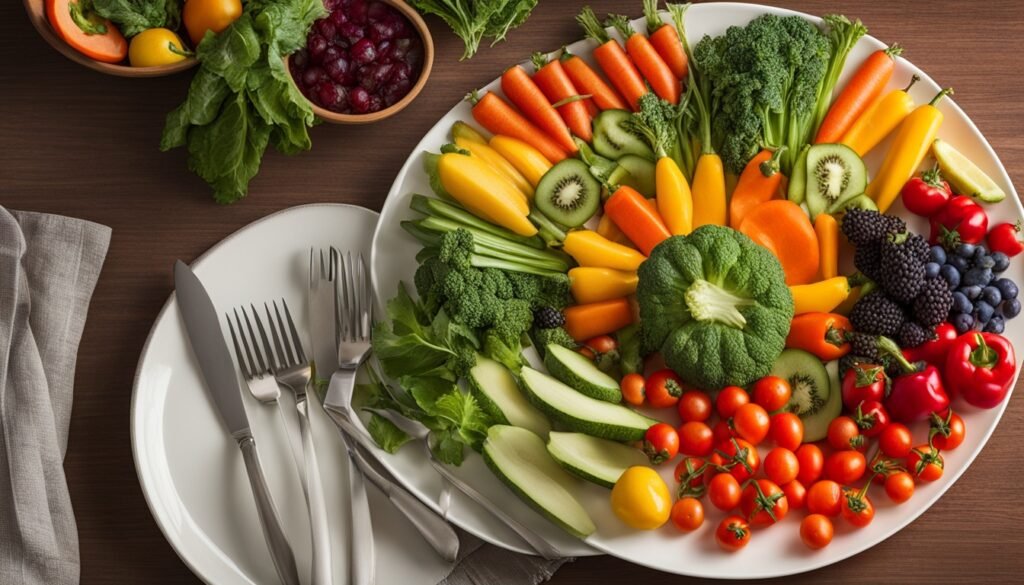Starting a weight loss journey can feel overwhelming, but it can also be a powerful change. This guide will show you how to lose weight in a healthy way. You’ll learn about meal plans, tasty recipes, and lifestyle tips to make you feel great, full of energy, and confident.
Table of Contents
ToggleKey Takeaways
- Discover the power of calorie-controlled diets and how to calculate your daily calorie needs.
- Explore a wide range of delicious weight loss recipes that cater to diverse palates and preferences.
- Master the art of portion control and mindful eating for lasting weight loss success.
- Understand the importance of balanced nutrition and the role of macronutrients and micronutrients.
- Incorporate metabolism-boosting foods and lifestyle habits to rev up your fat-burning engine.
- Adopt clean eating habits and learn to overcome weight loss plateaus for long-term results.
- Stay motivated and celebrate small victories throughout your weight loss journey.
Unlock the Power of Calorie-Controlled Diets
Creating a calorie deficit is a top way to lose weight. By understanding calorie deficits and figuring out your daily calorie needs, you can start losing weight for good. Let’s dive into the science behind this method and see how it can help you reach your fitness goals.
Understanding Calorie Deficits
Losing weight starts with a calorie deficit. This means eating fewer calories than you burn. By doing this, your body uses fat for energy, helping you lose weight. Aim for a calorie deficit of 500 to 1,000 calories a day for a slow but steady weight loss of 1 to 2 pounds a week.
Calculating Your Daily Calorie Needs
To find out how many calories you need, think about your age, gender, how active you are, and your weight loss goals. Online tools and formulas can help you figure out your basal metabolic rate (BMR) and total daily energy expenditure (TDEE). Knowing your calorie needs lets you plan a calorie-controlled diet that helps you lose the right amount of weight.
Successful weight loss isn’t just about cutting calories. It’s also about eating nutrition that’s balanced. By eating fewer calories but still getting enough nutrition, you can lose weight in a way that’s good for your health.
Delicious Weight Loss Recipes for Every Palate
Reaching your weight loss goals doesn’t mean giving up flavor or variety. Find a selection of healthy weight loss recipes that suit many tastes and diets. These meals are made to help you lose weight while still satisfying your cravings.
Our recipes include tasty low-calorie meals and clean eating dishes for everyone. Enjoy the Sunrise Sandwich for a protein-rich breakfast. Or try the Instant Pot Shrimp and Broccoli, a quick and low-calorie dinner. For a heartier option, the Chicken Under a Brick is juicy and nutritious.
These weight loss recipes support your healthy meal plans and fitness goals. They focus on balanced nutrition. Each dish is full of important nutrients, fiber, and macronutrients to keep you full and energized.
Looking for a tasty breakfast, a light lunch, or a fulfilling dinner? Our healthy weight loss recipes have you covered. Dive into the flavors, nourish your body, and start a tasty journey to your weight loss goals.
Mastering Portion Control for Sustainable Results
Mastering portion control is key to sustainable weight loss. Learning to listen to your body’s hunger and fullness cues is crucial. This can help you use Portion Control and Mindful Eating to meet your Weight Loss goals. We’ll cover effective techniques and Balanced Nutrition strategies for Sustainable Results.
Portion Control Techniques
Using portion control can change your weight loss journey. Begin with smaller plates and utensils to feel full with less food. Also, divide your plate into sections, saving the biggest part for veggies. Eat slowly and enjoy each bite to know when you’re full.
Mindful Eating Strategies
- Avoid distractions like TV or phones during meals. Focus on the taste, texture, and smell of your food.
- Do deep breathing before and during meals to connect with your body’s hunger and fullness signals.
- Keep a food journal to track your eating habits and spot patterns that lead to overeating.
By adding these Portion Control and Mindful Eating tips to your daily life, you’re on your way to lasting Weight Loss and a healthier lifestyle.
Balanced Nutrition: The Key to Successful Weight Loss
To lose weight for good, focus on balanced nutrition. Your body needs a mix of macronutrients and micronutrients to work well and help you reach your weight loss goals. Let’s look at why these elements are key for your health journey.
Essential Macronutrients for Weight Loss
Macronutrients like protein, carbohydrates, and healthy fats are vital for losing weight. Protein helps build muscle, which increases your metabolism. Carbs give you energy, and healthy fats help balance hormones and keep you full. The right mix of these nutrients helps you stay satisfied and manage your calorie intake.
Micronutrients for Optimal Health
Micronutrients like vitamins and minerals are also crucial for optimal health and managing weight. Vitamin C, zinc, and iron boost your immune system, while calcium and vitamin D are good for your bones. Eating a variety of nutrient-rich foods gives your body what it needs to perform well while you’re losing weight.
| Macronutrient | Role in Weight Loss |
|---|---|
| Protein | Builds and maintains lean muscle mass, boosts metabolism |
| Carbohydrates | Provides essential energy, supports healthy blood sugar levels |
| Healthy Fats | Supports hormone balance and satiety, promotes nutrient absorption |
With a balanced nutrition plan that includes the right mix of macronutrients and micronutrients, you’re setting yourself up for lasting weight loss and health.

Low-Calorie Meals That Satisfy
Keeping a calorie-controlled diet doesn’t mean you have to give up flavor or satisfaction. Explore a wonderful selection of low-calorie meals. These meals will help you meet your weight loss goals without feeling left out.
These dishes are packed with nutrients and support your healthy meal plans. They also give you the balanced nutrition your body needs. By choosing low-calorie ingredients and controlling portions, you can enjoy filling meals. These meals will keep you full and energized all day.
From tasty stir-fries to fresh salads, these low-calorie meals come in many flavors and textures. They’re made to keep you feeling full for a long time. This helps you stick to your weight loss plan.
Add these tasty low-calorie dishes to your meals every week. Discover the happiness of eating well without harming your health or taste buds.
Metabolism Boosters: Revving Up Your Fat-Burning Engine
Unlocking the secret to easy weight loss is all about understanding your metabolism. It’s the engine that burns calories in your body. By making it work better, you can lose weight faster and more effectively.
Regular exercise is a great way to boost your metabolism. Adding cardio workouts and strength training to your routine can increase your calorie burning and fat loss. This combo not only helps you lose weight but also builds muscle, making your metabolism even better.
Other lifestyle changes can also help your metabolism. Drinking plenty of water, eating spicy foods, and getting enough high-quality sleep can all speed up your metabolism.
Your metabolism is like a finely-tuned engine. The more you take care of it, the better it works. By adding these metabolism-boosting tips to your daily life, you’ll be on your way to reaching your weight loss goals.
“The key to sustainable weight loss is not just about cutting calories, but about fueling your body with the right nutrients and optimizing your metabolism.”
Fat-Burning Foods to Incorporate Into Your Diet
Your diet is key to losing weight. Adding the right fat-burning foods can help you lose those extra pounds. From lean proteins to fiber-rich foods, let’s look at the best options for your weight loss journey.
Lean Proteins for Weight Loss
Lean proteins are vital for keeping muscle mass while you’re cutting calories. They make you feel full and help you avoid overeating. Great lean protein choices are:
- Grilled chicken breast
- Lean ground turkey
- Wild-caught salmon
- Lentils and chickpeas
- Greek yogurt
Fiber-Rich Foods for Satiety
Fiber-rich foods are key for weight loss. They make you feel full and help you eat fewer calories. Add these fiber-rich foods to your meals:
- Berries (such as blueberries, raspberries, and blackberries)
- Leafy greens (like spinach, kale, and arugula)
- Whole grains (such as quinoa, brown rice, and oats)
- Avocados
- Chia seeds and flaxseeds
By eating these fat-burning foods often, you can increase your metabolism and feel more satisfied. This makes it easier to reach your weight loss goals.
Healthy Meal Plans for Weight Loss
Getting to a healthy weight takes careful meal planning. Luckily, there are many expert meal plans made just for that. They focus on calorie control, nutrient-dense foods, and proper portion sizes. These are the main things you need for losing weight.
At the heart of these healthy meal plans is managing calories. Knowing how many calories you need and eating fewer helps you lose weight safely. These plans make counting calories easy. They give you the right mix of nutrients to help you lose weight.
These plans also focus on balanced nutrition. They include lean proteins, complex carbohydrates, healthy fats, and fiber-rich foods. This makes sure your body gets all the nutrients it needs. It helps with weight loss and keeps you healthy.
Managing how much you eat is also key. These healthy meal plans show you how much to eat. This lets you enjoy your favorite foods but still lose weight. Learning to control your portions helps you keep losing weight over time.
If you want to lose a few pounds or more, these healthy meal plans are a great choice. They offer tasty and effective ways to lose weight. With calorie-controlled diets, balanced nutrition, and portion control, you can reach your goals and feel great.

Clean Eating Habits for Long-Term Success
Adopting clean eating habits is key for lasting weight loss and a healthy life. By cutting out processed foods and shopping mindfully, you can achieve long-term weight loss.
Eliminating Processed Foods
Processed foods are full of unhealthy additives and preservatives. These can stop your weight loss plans. Clean eating focuses on whole foods that feed your body and help you lose weight. Choose fresh fruits, veggies, lean proteins, and whole grains over packaged snacks.
Mindful Grocery Shopping
- Before shopping, make a list and stick to it. This prevents buying unhealthy items on a whim.
- Check nutrition labels for serving sizes, sugar, and artificial stuff.
- Buy whole foods that are rich in fiber, protein, and vitamins and minerals.
- Use more of your grocery money on fresh produce, lean proteins, and healthy fats for your clean eating lifestyle.
By choosing to shop mindfully and avoiding processed foods, you can change your eating habits for the better. Adopting a clean eating lifestyle leads to lasting weight loss and a healthier life.
“Eating clean is not about deprivation, it’s about nourishing your body with whole, natural foods that make you feel your best.”
Overcoming Weight Loss Plateaus
Reaching a weight loss plateau can feel like hitting a wall. But, with the right strategies, you can move past it and keep going towards a healthier life. It’s important to know why you hit a plateau, like metabolic adaptations and the need for calorie adjustments and workout routine variations.
A common reason for a plateau is metabolic adaptations. When you lose weight, your body changes how it burns calories, making it harder to lose more weight. To get past this, try adding high-intensity interval training (HIIT) or strength-training exercises to your workout routines. These can boost your metabolism and help you burn fat again.
Also, check your calorie intake often and adjust as needed. Your calorie needs change as your weight does. Keeping track of your calorie intake and expenditure helps you find the right calorie deficit for steady weight loss.
Lastly, remember the power of lifestyle changes. Trying new workout routines, meal plans, and healthy habits can help you break through a plateau. Experiment with different things to see what suits you best.
Overcoming a weight loss plateau requires patience, persistence, and a willingness to adapt. By tackling the root causes and making smart changes, you can get past the plateau and keep moving towards a healthier, fitter you.
“The key to breaking through a weight loss plateau is to continually challenge your body and mind with new approaches.”
Staying Motivated on Your Weight Loss Journey
Weight loss is a tough but rewarding journey. It’s key to keep motivated for lasting results. If you’re starting or stuck, focus on your goals and celebrate small wins. This keeps you inspired and committed to your health and fitness goals.
Setting Realistic Goals
Setting achievable goals is key to staying motivated. Realistic Goals keep you positive and track your progress. Think about your fitness level, lifestyle, and what you want to achieve. Then, set specific, measurable, and timely goals that fit your needs and likes.
- Break down your big goals into smaller steps
- Focus on building healthy habits, not just the end result
- Regularly check and tweak your goals to keep them challenging and relevant
Celebrating Small Victories
It’s vital to celebrate Small Victories on your weight loss path. These can be anything from fitting into new jeans to beating a workout record. Acknowledging your progress helps you stay positive and motivated for Sustainable Results.
| Small Victory | Celebration Idea |
|---|---|
| Drinking more water daily | Treat yourself to a new reusable water bottle |
| Completing a challenging workout | Schedule a relaxing spa day |
| Sticking to your meal plan for a week | Enjoy a healthy, indulgent meal out |
Your Weight Loss Motivation is personal, so pick what fits your life best. With a positive outlook and focus on Realistic Goals and Small Victories, you’re on your way to the Sustainable Results you want.
Conclusion
We hope this guide has given you useful tips and strategies for healthy meal plans. These plans can help you lose weight and keep a healthy lifestyle. By focusing on balanced nutrition, controlling portions, boosting your metabolism, and eating clean, you have the tools to reach your weight loss goals.
This guide showed how important it is to watch your calories, try tasty weight loss recipes, and understand the role of nutrients in managing weight. Mastering portion control and eating mindfully can help you succeed with a calorie-deficit diet.
Remember, losing weight sustainably is more than just watching the scale. It’s about taking care of your body, mind, and overall health. Adopt clean eating habits, eat foods that boost your metabolism, and stay motivated. With hard work and a positive attitude, you can break through weight loss challenges and start a journey to a healthier, happier life.
FAQ
What is the importance of creating a calorie deficit for weight loss?
Creating a calorie deficit is key for losing weight. By eating fewer calories than your body burns, you make your body use stored fat for energy. This leads to slow and steady weight loss.
How can I calculate my daily calorie needs for weight loss?
To figure out your daily calorie needs, think about your age, gender, how active you are, and your weight loss goals. Use online calculators or formulas to find your basal metabolic rate and the right calorie intake for losing weight.
What are some effective portion control techniques?
Good portion control tips include using smaller plates, measuring your food, eating slowly, and paying attention to when you’re hungry or full. These methods help you eat less without feeling left out.
Why is balanced nutrition important for successful weight loss?
Eating a balanced diet with the right mix of nutrients is key for losing weight. It helps your metabolism, keeps muscle mass up, and supports your health while you’re losing weight.
What are some low-calorie meals that can help me feel satisfied?
Eating meals that are low in calories but packed with nutrients can make you feel full and support your weight loss. Try grilled chicken with veggies, quinoa and black bean bowls, or lean protein stir-fries with lots of fresh produce.
How can I boost my metabolism to aid in weight loss?
To boost your metabolism and burn more calories, exercise regularly, do strength training, drink plenty of water, and eat foods that help your metabolism like lean proteins, spicy foods, and green tea. These habits can increase your calorie burn.
What are some fat-burning foods I should include in my diet?
Adding foods like lean proteins, fiber-rich fruits and veggies, and healthy fats to your diet can help with weight loss. These foods make you feel full, help keep muscle, and improve your body’s fat-burning ability.
How can I overcome weight loss plateaus?
If you hit a weight loss plateau, try eating fewer calories, trying new workouts, and making lifestyle changes. Check your calorie needs, change your exercise routine, and address any metabolic changes that might be slowing you down.
How can I stay motivated throughout my weight loss journey?
Stay motivated by setting achievable goals, celebrating your successes, and keeping a positive attitude. Having a supportive community, tracking your progress, and enjoying your healthy lifestyle can help you stay on track and reach your goals.









